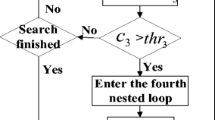Abstract
This paper proposes a new speech steganography system for secure sound massages sharing. This system exploits the advancements in speech processing to hide efficiently secret speech in narrowband cover speech. Linear predictive coding is used to represent the secret speech with reduced number of parameters. These parameters are embedded in selective perceptually-irrelevant frequency locations of the cover speech. Objective and subjective measures show that the resulting stego speech, which contains the secret message, is indistinguishable from the cover speech.
Access this chapter
Tax calculation will be finalised at checkout
Purchases are for personal use only
Preview
Unable to display preview. Download preview PDF.
Similar content being viewed by others
References
Potapova, R.O., Ponomar, M.O.: Prospects of applications of speech steganography. XVIII Session of the Russian Acoustical Society, September 11-15 (2006)
Artz, D.: Digital steganography: Hiding data within data. IEEE Internet Computing, pp. 75–80 (May-June 2001)
Aoki, N.: A band extension technique for G.711 speech using steganography. IEICE Transaction on Communication E89-B(6) (June 2006)
Guerchi, D., Harmain, H., Rabie, T., Mohamed, E.: Speech secrecy: An FFT-based approach. International Journal of Mathematics and Computer Science 3(2), 1–19 (2008)
Tremain, T.E.: The Government standard linear predictive coding algorithm. In: Speech Technology, pp. 40–49 (1982)
Guerchi, D., Qian, Y., Mermelstein, P.: Pitch-synchronous linear-prediction analysis by synthesis with reduced pulse densities. In: IEEE International Conference on Acoustics, Speech, and Signal Processing, Istanbul, Turkey, vol. 3, pp. 1491–1494 (June 2000)
Itakura, F.: Line spectrum representation of linear predictive coefficients. Journal of Acoustics Society of America 57(1), S35 (1975)
Shah, J.K., Iyer, A.N., Smolenski, B.Y., Yantorno, R.E.: Robust voiced/unvoiced classification using novel features and gaussian mixture model. In: IEEE International Conference on Acoustics, Speech, and Signal Processing, Montreal, Canada, May 17-21 (2004)
Salami, R.A., et al.: Design and Description of CS-ACELP: A Toll Quality 8 kb/s Speech Coder. IEEE Transactions on Speech and Audio Processing 6(2), 116–130 (1998)
Alku, P., Backstrom, T.: Linear predictive method for improved spectral modeling of lower frequencies of speech with small prediction orders. IEEE Transactions on Speech and Audio Processing 12(2), 93–99 (2004)
Paliwal, K.K., Atal, B.S.: Efficient vector quantization of LPC parameters at 24 bits/frame. IEEE Transactions on Speech, and Audio Processing 1(1) (January 1993)
ITU-T P.800, Methods for subjective determination of transmission quality (1996)
Author information
Authors and Affiliations
Editor information
Editors and Affiliations
Rights and permissions
Copyright information
© 2012 Springer-Verlag Berlin Heidelberg
About this paper
Cite this paper
Guerchi, D., Mohamed, E.E. (2012). LPC-Based Narrowband Speech Steganography. In: Benlamri, R. (eds) Networked Digital Technologies. NDT 2012. Communications in Computer and Information Science, vol 294. Springer, Berlin, Heidelberg. https://doi.org/10.1007/978-3-642-30567-2_23
Download citation
DOI: https://doi.org/10.1007/978-3-642-30567-2_23
Publisher Name: Springer, Berlin, Heidelberg
Print ISBN: 978-3-642-30566-5
Online ISBN: 978-3-642-30567-2
eBook Packages: Computer ScienceComputer Science (R0)




